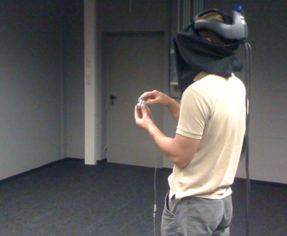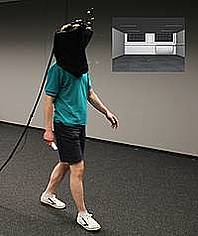FOV Calibration


Immersive virtual reality (VR) environments allow users to observe virtual environments (VEs) from an egocentric perspective. However, several experiments have provided evidence that egocentric distances are perceived as compressed in VEs relative to the real world. The principal factors responsible for this phenomenon have remained largely unknown.
Head-Mounted Displays (HMDs)
Head-mounted displays (HMDs) consist of small display units mounted in front of a user's eyes, on which rendered views to a VE can be displayed, to provide the user with an egocentric view to a virtual world. Recent experiments suggest that the virtual view frustum set for rendering the VE on a HMD has an essential impact on a user's estimation of distances. Unfortunately, it is not trivial to correctly set this view frustum for a given HMD and user such that the VE is rendered in a consistent way without mini- or magnification of the scene.
We (a) proposed psychophysical calibration schemes, which can be used to accurately calibrate such HMDs, and (b) analyzed the effects of correctly defined view frustums on a user's distance estimation.
In particular, we conducted experiments based on blind walking and blind grabbing. We found the tendency that a calibrated view frustum reduced the average distance underestimation of users, but even a correctly calibrated view frustum could not compensate entirely for the distance underestimation effects. The question why such underestimation effects occur in immersive VEs remains an interesting and challenging research direction.
